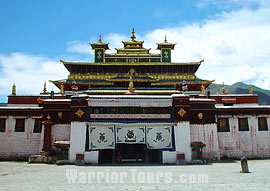- Attractions
- Monasteries
Monasteries in Shannan

![]() Samye Monastery
Samye Monastery
Located at the foot of Hepori Mountain and north of the Yarlong Tsangpo River, Samye Monastery is about 30 kilometers (18 miles) from Tsedang. Holding the title 'the First Monastery of Tibet', Samye Monastery was built by the two famous India monks, Padmasambhava and Santarakshita, under the orders of King Trisong Detsen in the eighth century. Soon after the construction finished, King Trisong Detsen ordered seven Tibetan nobles tonsured at Samye Monastery, and they became the first group of monks in Tibet.
At the center is the large, three-storied Great Hall. Covering an area of more than 6,000 square meters (about 1.48 acres) and facing the east, the Great Hall is unique because of its special styles. The first floor is Tibetan style; the second is Chinese Han style while the top floor is Indian style. All the murals and statues in each floor are also painted or sculpted in the three styles. Samye is also called 'Three Styles Monastery'. Murals on the wall are also splendid. The beginning of Tibetan, the foundation of the Yellow Hat Sect, the stories of Samye Monastery and Padmasambhava and the outstanding achievements of the ninth Dalai Lama are all depicted vividly by the murals.

The layout of Samye is complicated. According to the world view of Buddhism, the Great Hall is just like the center of the world where Buddhas live. The Sun and Moon Chapels encircled the Great Hall represent the sun and the moon. Four chapels and eight small chapels scattered in all directions embody four continents and eight eparchies where common people live. In addition, four Stupas representing the Four Heavenly Kings can be found around outside perimeter of the Great Hall.
As Samye is far away from Tsedang or Lhasa, visitors have to take a coach to the Samye Ferry first. About CNY 10 is requestd to travel on an open, flat-bottomed ferry (along with about 50 people) which takes them to the northern bank of the Yarlong Tsangpo River. After landing, a motorcar from Samye Monastery are waiting for any services.
| Admission Fee: | CNY 45 |
| Recommended Time for a Visit |
Two to three hours |
![]() Mindroling Monastery
Mindroling Monastery
As the most important monastery of Nyingmapa (or the Red Sect), the Mindroling Monastery lies east of the Dranang River in Dranang county. Surrounded by mountains and facing east, Mindroling was originally built in the 17th century and rebuilt in 1720.
It covers an area of more than 100,000 sq meters (about 24.8 acres) with the Main
Chanting Hall as the major construction. Nyingmapa, the oldest sect of Tibetan Buddhism, was founded by Padmasambhava (an Indian monk who introduced Esoteric Buddhism into Tibet) in the eighth century and retains many elements of tantra and pre-Buddhist Bon faith. Murals of Buddha in the hallways are awesome with many painted heads and arms which is very different from other sects of Tibetan Buddhism. Monks of Nyingmapa are allowed to marry and the throne of the abbot is passed on from father to son or son-in-law. Mindroling is also famous for its research in astronomy and astrology as well as calligraphy. Terdak Lingpa, the tutor of the Fifth Dalai Lama, was one of the many high lamas of Mindroling who were chosen to teach in Potala. Mentsekhang, where the Tibetan calendars are compiled, also continues to invite many high lamas from Mindroling every year.
Admission Fee: CNY15

![]() Trankdruk Monastery
Trankdruk Monastery
Trankdruk Monastery lies five kilometers (3 miles) south of Tsedang, on the east bank of the Yarlung River. It was originally built during the reign of King Songtsen Gampo, and used as the winter palace for the King and his Chinese wife, Princess Wen Cheng.
Trankdruk consists of a Great Hall, an aisle around it and a yard. The statues of Songtsen Gampo, Princess Wen Cheng, Sakyamuni and Chenrezi are enshrined on the first floor. A statue of Padmasambhava, who studied and practiced here in the past, is located in the middle of the second floor. An invaluable treasure, a pearl thangka depicting Chenrezi in repose, is also preserved in the Trankdruk Monastery. This fabulous thangka was made of almost 30,000 pearls as well as a diamond, two rubies, many other gems including sapphire, gold, and coral. Although this tangka was made around Yuan Dynasty (1271 - 1368), it is still well preserved. A thangka which was made by Princess Wencheng is also in good condition.
Admission Fee: CNY70
Recommended Time for a Visit: One and a half hours

